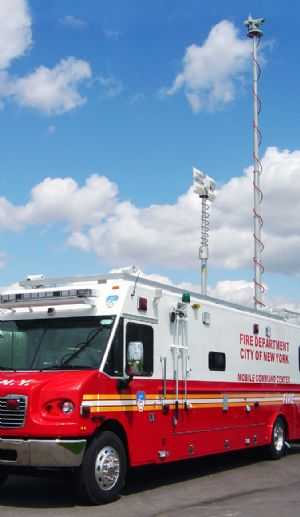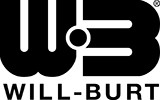
There are many considerations when it comes to specifying light towers and telescoping masts for a mobile command center.
Deciding whether you want high intensity scene lighting, cameras for surveillance, weather stations or microwave equipment for communications transmission is much easier done and accommodated for in the specification process. Appropriate power sources and tower and mast placement must be planned for in the design stage of the mobile command center.
Scene Lighting: Telescoping light towers are a convenient way to meet the needs of nighttime operations. With varying terrain and operational needs, be sure to specify the height of the telescoping system. Systems can be installed that are upwards of 40 feet.
Critical also is how much light is necessary. With many options for lighting packages including quartz halogen, metal halide and H.I.D., a custom system can be configured for the illumination necessary to function properly at night.
The light tower can be a roof mounted tower or a vertical tower that is mounted external or internal to the vehicle. Remote control is typically standard with a panel mount control as an option.
Make sure the tower includes dual tilting. Dual tilting allows the bank of lights on each side to shine independent of one another. This ensures the most scene illumination possible during an emergency operation.
Communications Equipment: Communication during any rescue or disaster operation is paramount. Mobile command centers should be outfitted with communications equipment. Selecting the correct telescoping mast to elevate your equipment includes evaluating the weight of the payload and the needed height of the mast.
Additional items including antenna stub adapters, mast extension warning lights and mounting hardware should be included with the mast.
Surveillance Systems: When specifying a surveillance system, a telescoping mast and camera package are necessary. As with communications equipment, selecting the mast based on required extended height is important. Specifying payload capacity for the camera system is another consideration when selecting the telescoping mast.
A mast can be selected separately from the camera system or both can be provided for based on the specifications.
Weather Stations: Environmental equipment can be elevated on a . Weather stations can be quickly deployed when mounted on a mast. Raised to heights consistent with terrain, most requirements can be accomplished with a 60 ft. (18 m) extended mast or less. Payload for a weather station must be considered. A payload up to 200 lbs. (90 kg) is typical but masts that provide greater capacity are also available.
Safety: With the use of any equipment that extends into the air, safety is very important. The D-TEC II Safety System is available for use a top any telescoping mast or light tower. This system provides AC field detection, object proximity detection, tilt sensor detection and above the mast illumination.






